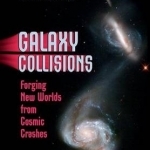Galaxy Collisions: Forging New Worlds from Cosmic Crashes
BookThis item doesn’t have any media yet
2011 | Science & Mathematics
The spectacular images of galaxy collisions capture the imagination. This book will show what is out there in the universe, what it's like in other galaxies, what they might look like, and how cosmic processes might affect life in other solar systems. It will explain crucial stages in the development of physical structure in the universe, and the effect of galaxy scale processes. Professor Struck will explore all the issues surrounding galaxy collisions. He will begin with a brief broad review of the background on galaxies, the history of their discovery, and how this has been driven by steadily improving technology. Chapters 2 gives details of the early stages of different types of galaxy collision - Rings of Fire, Tidal Swings and Retrograde and Sideways Reels - while Chapter 3 describes collisions between galaxies of very different masses: minor merger or dwarf destruction. Chapter 4 covers ultra-luminous infrared galaxies and major mergers and Chapter 5 briefly examines the techniques used for computer simulation results and how increasing computer capacity has affected the development of this field.
The following chapter looks at understanding the physical processes of triggered star formation and nuclear activity. Chapters 7-9 look at the broader view of cosmological structure growth which determines the environment and conditions in which galaxy collisions occur. In the densest environments, this process repeats itself on the larger scale of galaxy clusters. The concluding chapter considers what a galaxy collision looks like from a solar system like ours. Although the galaxy is completely restructured and the night sky view would change greatly over the course of several hundred million years, the direct effects on our planet would be few and infrequent, with only a small probability of being truly catastrophic. These issues will be explored along with the ideas that galaxies must reach a certain evolutionary 'maturity' before they can even form solar systems, and that there are habitable zones within galaxies. Thus, galaxy scale processes, like collisions, can determine the fate of life on Earth-like planets.
Related Items:
| Published by | Springer-Verlag New York Inc. |
| Edition | Unknown |
| ISBN | 9780387853703 |
| Language | N/A |
Images And Data Courtesy Of: Springer-Verlag New York Inc..
This content (including text, images, videos and other media) is published and used in accordance
with Fair Use.
